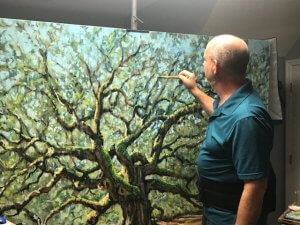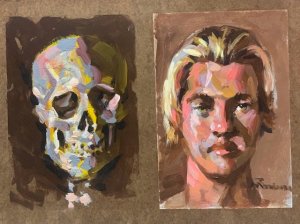Forward from “The Power of Positive Painting”
A lot has changed in the art world in the forty plus years since I embarked on my career. Academia is finally embracing contemporary realism – realism that has something important to say about our world. Meanwhile, popular how-to books, TV shows and Paint with Wine experiences have democratized the art world to such an extent that an entire generation of non-academia has been raised to believe making art is about mimicking someone else’s “starving artist” painting or replicating anime characters. The art world remains polarized between these two forces, the intellectual and the mundane, resulting in a society which is being robbed of meaningful creative experiences.
The Goal of this Book – The good news is there is a healthy space between this rock and a hard place where beauty and creativity is thriving. The Power of Positive Painting (P3) does not proffer esoteric philosophical theories. Nor does it include glib techniques and cookie cutter formulas. The P3 is a clear, concise method that has helped thousands of serious-minded painters to translate what they see into something memorable and powerful.
Learning the Craft – Most representational teachers take the process of seeing for granted. Maybe they are hoarding the ancient knowledge. Or maybe they just never quantified the process itself. They seem to be saying, “artists are born, not made.” I disagree with that premise. I have found that anyone open and willing to apply themselves in learning the fundamentals of seeing can also learn how to draw and paint what they see. I believe anyone can become a fully self-expressed artist, using the P3 method as a springboard to develop their own unique artistic voice. A particular source of pride for me, is that I have trained many artists who went onto more illustrious careers than I. In the final analysis, how one applies this secret knowledge is what distinguishes one great artist from another.
 What is the P3 Method? In my earlier book, Point of Art, I focused primarily on the why of art. I explored academia, the art market and pop culture. I also included some helpful tips on drawing and painting. The Power of Positive Painting is my long awaited, step by step illustrated method, focused on the how. It is intended to simplify the fundamentals of drawing and painting, while honoring the teachings of the masters. My goal is for you to become an insider, to fill your toolbox with skills that will help you add depth, drama and directness to your paintings. I focus a lot on portraiture, but the method can be applied to multiple genres. Beginners, intermediate and advanced artists can benefit from The P3 method.
What is the P3 Method? In my earlier book, Point of Art, I focused primarily on the why of art. I explored academia, the art market and pop culture. I also included some helpful tips on drawing and painting. The Power of Positive Painting is my long awaited, step by step illustrated method, focused on the how. It is intended to simplify the fundamentals of drawing and painting, while honoring the teachings of the masters. My goal is for you to become an insider, to fill your toolbox with skills that will help you add depth, drama and directness to your paintings. I focus a lot on portraiture, but the method can be applied to multiple genres. Beginners, intermediate and advanced artists can benefit from The P3 method.
In my classes and workshops, I have encountered artists who are committed to achieving a mastery of honest observational skills. Armed with some basic information they are now interpreting what they see in a simple, bold and specific way. The power of positive painting, as the title suggests, is about learning to paint with confidence and conviction. It is a compilation of the methods and approaches I have culled from a variety of sources, which I have expanded on and developed over a period of forty years.
The P3 is an effort to demystify the secret knowledge of the masters, which my father, the great artist, Joseph Maniscalco, passed down to me. His teacher, Frank Reilly, learned from NC Wyeth and Howard Pyle, who studied with the masters from the late 1800s. Andrew Wyeth, his son, was one of a handful of artists, including my father, who kept the secret knowledge of the masters alive through all the art isms of the twentieth Century. My goal is to extend this lost knowledge forward into the 21st Century.
Get “The Power of Positive Painting”


 Would you like to get inspiration in your inbox, rather than ads for more stuff? Welcome to ManiscalcoGallery.com
Would you like to get inspiration in your inbox, rather than ads for more stuff? Welcome to ManiscalcoGallery.com